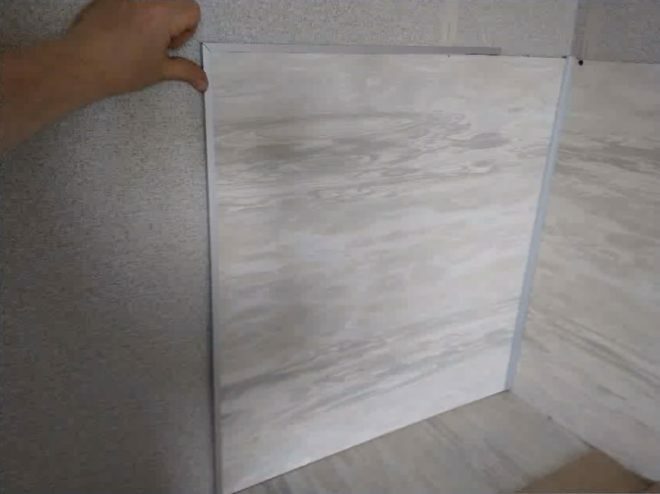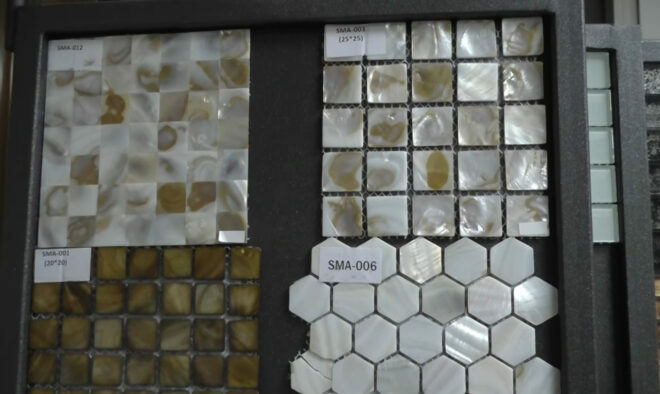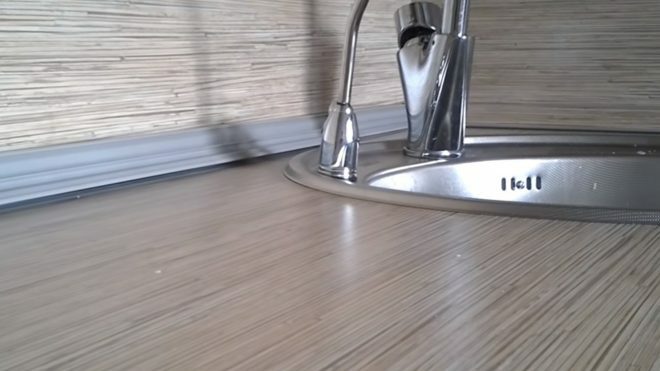An apron made from decorative artificial or natural stone is beautiful, expensive and almost timeless. However, it is not as invulnerable, as it seems, and requires, firstly, a careful choice of finishing material, and secondly, proper care. From this article you will learn what kind of artificial and natural stones are, what they have pros and cons, how to choose the least branded mineral and how to take care of it. A selection of design ideas will help you compile 40 photos of kitchen interiors with stone aprons.
See also our base material: How to choose an apron for the kitchen - customer reference
About the artificial stone( agglomerate and acrylic)
Two types of artificial stone - agglomerated and acrylic - are used to finish the apron.
- Acrylic Stone( Corian) is a composite material of acrylic resins, pigments and natural minerals. It is durable, but at the same time more flexible and lightweight than agglomerated and natural stone, it is easily cleaned, mounted, repaired, cut to the desired shapes and sizes. However, Corian is scratch sensitive and is afraid of contact with very hot objects. For example, a frosted spot can remain on a hot cast-iron pan on an acrylic apron.

Acrylic stone in the decoration of the classic kitchen apron

Acrylic stone in the decoration of the classic kitchen apron
- Agglomerate is a material that consists of not less than 90% natural minerals, everything else is pigments, decorative glass / mirror additives, and a binder- polyester resins. This composition makes the agglomerate super-durable, scratch-resistant, easy to clean( unlike natural stones), as natural as possible and more affordable. True, to mount, transport, repair and polish an apron from an agglomerated composite is almost as easy as stone aprons. Even to the touch, the agglomerate is almost as cold as granite or marble.
In general, it can be said that both acrylic and agglomerated stone are preferable to natural:
- Unlike a natural mineral, acrylic and agglomerate do not have pores, and therefore are hygienic and unpretentious in care. Moreover, unlike granite and marble, they are not afraid of acids. Neither beet juice, nor coffee, nor lemon will leave a trace on the apron under the stone.
- Artificial stone allows you to create monolithic structures without seams and give the edges of the panel a beautiful curly shape, for example, in the form of a crown as in the photo below.
- silicon The acrylic stone lends itself to local and complete repair. Chips, cracks, scratches and gouges are easily removed with the help of special glue for restoration, grinding and polishing.
- Externally, an artificial stone( especially agglomerate) is very similar to its natural prototype, it can be matte or glossy, have a uniform texture or a pronounced pattern with veins or patches.
- In a pair to the "stone" apron, you can and should choose a tabletop from the same material, as well as a window sill and bar counter.
The disadvantages of acrylic stone include a high price( sometimes it can cost more than natural material), lower strength and scratch resistance, and artificial origin.
Tips for the buyer:
- When choosing an apron made of acrylic stone, you should prefer a light-colored cloth with a mat or a satin to look like a mat, or a mat, or a marble, with a marble or a marble. On this background, scratches, water droplets, stains and dirt stains will be less noticeable. But the glossy aprons, especially in dark color, will require you to double cleaning, because even small specks of dust are visible on them, not to mention fingerprints.
- Do not wash the apron made of artificial stone with hard brushes and sponges, as well as abrasive, alcohol and acid-containing cleaning agents.
- Polish the surface of the apron once every two years.
About natural stones
The main advantage of an apron made of natural stone is its natural and “living” beauty, which cannot be artificially recreated. In addition, the stone is very durable and can serve not years, but centuries. In all other respects, natural minerals, unfortunately, lose their imitations.
Firstly, due to the porous structure, all stones to a greater or lesser extent absorb moisture, and along with it dirt, grease and coloring pigments from products. To prevent this from happening, stone surfaces should be treated at least once a year with silyings - special protective impregnations for sealing pores.
Secondly, they react to acids. For example, lemon splashes can leave dull stains on a stone wall( they can be noticeable at a certain angle).Other disadvantages of natural stones include their radioactive background( insignificant, but still), the presence of seams between slabs or tiles, and, of course, the high price. Yes, and work with them more difficult because of the severity and hardness. For example, in order to cut a hole for a socket in a stone slab, you will need a diamond-coated disc.

The shade, pattern and texture of each stone apron is unique and not made by hands.
The apron can be faced with three natural stone formats: slabs, tiles and mosaics.
- The slabs of the are large slabs with a thickness of about 2 cm, which, due to their size, make it possible not to split up the natural pattern of the stone, but to represent it as completely as possible. Apron decoration with slabs - the most spectacular and luxurious, but expensive and complicated.

Marble slab in the decoration of an apron of a modern kitchen in the “Garden Quarters” residential complex in Moscow
- The stone tile resembles ordinary ceramic tiles, because it also has standard sizes( 30 × 30, 40 × 30, etc.) and sometimes requires a pattern to be joined. Stone in tiles is cheaper than slabs, it is easier to transport and fit. However, the apron of stone tiles has seams, which somewhat complicate its cleaning and require periodic updating of the grout.
- Mosaic from natural stone is a mats with mini-tiles already laid out of one or more types of stones, sometimes in combination with tiles made of glass, ceramics, smalt and other materials. The drawing of a mosaic made of stone can be both very simple and very complex - in the form of a panel.
See also: All about kitchen apron from mosaic and even more
The most popular types of stones for facing kitchen apron are granite, marble, travertine.
Granite
Granite is excellent for finishing the apron, as it is very hard and dense, which means unpretentious and durable. Neither fat, nor food dyes such as beets, nor brushing with a brush, nor open fire, nor frost are afraid of him. In addition, granite can be picked up in the right shade for you, because its palette has almost a thousand tones. The most common and inexpensive granite is gray-pink, but you can choose green, black, brown, yellow, red, and even white stone.





Marble
Marble - this is perhaps the most beautiful and at the same time capricious stone. It is so not resistant to acids that even spilled kefir leaves on it matte spots. And because of its porosity and microcracks, marble very quickly absorbs moisture, and therefore any food colors. However, if the marble is well polished and impregnated with a hydrophobic composition, then coloring liquids and products, say, coffee or beets will not be so terrible. The main thing is to have time to remove stains and liquids as quickly as possible and always have on hand special tools for marble cleaning.

White kitchen with marble apron

Travertine
Travertine( lime tuff) is an intermediate link between limestone and marble, so it has properties characteristic of both minerals. The apron from travertine is strong, is not afraid of differences of temperatures, fire. However, it is less dense than marble, and is also afraid of acids and coloring products / liquids. In order for the travertine apron not to get dirty and always look good, it must be perfectly polished and treated with hydrophobic impregnation, self-polishing wax and mastic.


Another difference in travertine is its variety of patterns and shades. The apron from this stone can be white, beige( the most common color), brown, rich red.
- By the way, expensive natural travertine has a more budgetary alternative - flexible stone, consisting of a 1.2.5 mm thick sandstone cut, a bonding polymer and a textile base. Externally, an apron made of flexible stone is practically indistinguishable from the original, unpretentious in maintenance, can last up to 40 years, is subject to local repair, and due to its softness and flexibility it is easily mounted even without the help of specialists. The only drawback of a flexible stone is a limited number of shades( only a few dozen).In addition, an apron made of flexible stone requires the same care as aprons from slabs or tiles, that is, timely cleaning of liquids and processing with protective impregnations 1 time per year.


Buyer's Tips:
- When buying a stone apron, make sure it is well polished. And before you begin to use it, soak the apron twice with protective impregnation and a brush( the first layer should dry completely).
- You need to handle a stone apron about once a year.
- Buy natural stone only from reputable manufacturers to avoid buying high-activity mineral.
- Laying tiles with stone, especially marble or travertine, can be trusted only to high-class professionals.
Read also:
- How to choose a tile for an apron: 12 nuancesand a review of popular formats
- The correct size of the apron - the secret of a convenient kitchen
- Plastic apron - information for customers
- Everything about glass kitchen aprons - from skins to
- plexiglass MDF wall panels in the decoration of the apron and kitchen walls
- Guide to choosinghave false panels for the kitchen and installation instructions
























